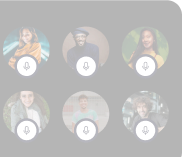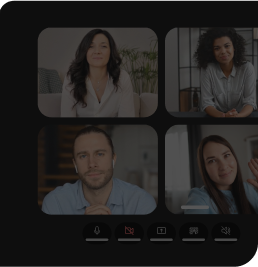In today's digital age, the demand for integrating video features into our applications and websites is soaring. Whether you're in the process of developing a video conferencing platform, a live streaming app, an interactive e-learning tool, a video recording application, a voice communication tool, a video editing suite, or a comprehensive video solution, it's essential to understand the potential of Video Software Development Kits (SDKs) and Application Programming Interfaces (APIs). These tools serve as the building blocks that can help you incorporate powerful video features into your application, enhancing its functionality and user experience. With a multitude of options available, let's dive into the different categories of video SDKs and APIs, explore how they function, and their use cases in various development scenarios.
So, let's get started!
Types of Video SDK & APIs
We'll deep dive into different types of Video SDK & API platforms like Video Conferencing SDK, live streaming SDK, video recording SDK, voice calling SDK, video recording SDK and video editing SDK.
Video Conferencing SDK & API
Video meetings have become an integral part of modern communication and collaboration. To ensure a robust foundation for real-time video and audio communication, Video SDKs and APIs play a pivotal role. These tools serve as the backbone for setting up video conferencing systems, offering several essential aspects to consider:
- Seamless Integration: Video SDKs and APIs are designed with the utmost simplicity in mind, making it easy to integrate them into web and mobile applications. This streamlined integration process ensures the hassle-free setup of video meetings.
- Reliability and Scalability: In the world of video conferencing, reliability and scalability are paramount. These tools are known for their consistent and dependable performance, making them suitable for both small-team meetings and large-scale conferences. They ensure that your video meetings go off without a hitch.
- Feature-Rich: Video SDKs and APIs often come equipped with a wide array of features, including screen sharing, chat functionality, and more. These features enhance interactive collaboration during video meetings, providing a rich and immersive experience for participants.
Use Cases:
- Remote Work: Video SDKs and APIs are essential for virtual team meetings and collaboration, bridging the geographical gaps between remote team members and fostering productivity.
- Online Education: In the world of e-learning, these tools are invaluable for virtual classrooms and online education platforms. They enable educators to engage with students, share content, and create dynamic learning experiences. Dive deeper into the future of online education with Dyte.
- Telemedicine: Telemedicine or telehealth relies on the ability to establish remote doctor-patient consultations. Video SDKs and APIs play a critical role in facilitating secure and effective healthcare communication, ensuring the well-being of patients.
Video Conferencing SDK & API Platforms:
- Dyte: Dyte offers a comprehensive video conferencing API and SDK, providing developers with a versatile and feature-rich solution for real-time communication needs.
- Zoom: Zoom has become a household name in the world of video meetings. They also offer SDKs to build video applications. Learn more about Zoom SDK pricing to better evaluate.
- WebRTC: WebRTC, as an open-source project for real-time communication, provides a versatile and customizable solution for developers, empowering the creation of real-time communication applications with flexibility and adaptability.
You can check out this for a much better understanding: Top 10 video conferencing APIs
Live Streaming SDK & API
In the world of live streaming, video SDKs and APIs are the cornerstone of real-time engagement. These versatile tools enable the seamless transmission of video and audio data over the internet, allowing for interactive and live content sharing. Key pointers in this category include:
- Real-Time Interaction: SDKs and APIs in this category facilitate instantaneous video sharing, making them ideal for live events, social platforms, and more.
- Scalability: These tools provide the necessary infrastructure to handle large audiences and scale seamlessly.
- Cross-Platform Support: Many of them offer compatibility across various platforms, ensuring a broader reach.
Use Cases:
- Live Events: Ideal for live sports events, concerts, and webinars. Discover how Dyte is revolutionizing live events.
- Social Platforms: Essential for real-time video sharing on social media.
- Gaming: Popular for game streaming and live interactions.
Live Streaming SDK and API Platforms:
- Dyte: Empowers developers with real-time video communication capabilities.
- Twilio Video: Offers video calling APIs.
- Agora: Provides real-time engagement APIs for various use cases.
- Wowza: Specializes in live streaming services and APIs.
Video Recording SDK & API
Video recording is the process of capturing and preserving video content, and the role of Video SDKs and APIs in this category is pivotal for effective management, storage, and retrieval of video content. Here are some key takeaways:
- Access to Video Libraries: These tools empower applications to access extensive video libraries, making them invaluable for content management and enabling seamless video discovery. With these capabilities, you can effectively organize and showcase your video content.
- Metadata and Interaction: Video SDKs and APIs allow you to fetch detailed video information and user interactions. This not only enhances the user experience but also provides valuable insights into how your video content is being consumed and engaged with.
- Customization: Video SDKs and APIs provide the flexibility to customize and engage with users, creating a unique and personalized video experience. This enables you to tailor the video content to meet your specific goals and branding.
Use Cases:
- Content Creation: Video recording SDKs and APIs are invaluable for content creators, including vloggers, video tutorial producers, and those creating video diaries. They offer the necessary tools for capturing and managing video content.
- Security Systems: In the realm of security, these tools are essential for surveillance and video evidence collection. They ensure the reliable recording and storage of video data for security and legal purposes.
- Media Libraries: Organizations with large video libraries, such as media companies and educational institutions, benefit from video recording SDKs and APIs for efficient organization, access, and retrieval of video content.
Video Recording SDK & API Platforms:
- Vimeo: Known for its video hosting and streaming APIs, Vimeo provides a robust platform for hosting, managing, and streaming video content. It is a trusted name in the industry.
- Kaltura: Kaltura offers video platform solutions tailored to various industries. Its versatile offerings encompass video recording, management, and distribution for a wide range of applications.
- Brightcove: Brightcove specializes in video hosting and monetization solutions, making it an ideal choice for businesses looking to not only record and manage videos but also monetize their content effectively.
Voice Calling SDK & API
Voice communication is a fundamental element of video-driven applications, playing a pivotal role in ensuring crystal-clear and reliable audio transmission. Video SDKs and APIs are the cornerstone of high-quality voice communication, offering a range of features to enhance the user experience. Here are the key highlights:
- Interactive Audio: These tools are expertly crafted for interactive voice communication, whether you're developing voice chat apps, virtual classrooms, or providing exceptional customer support.
- Additional Features: Many of these SDKs and APIs extend beyond pure voice communication, offering features like screen sharing and text-based interactions, elevating the overall user experience.
- Platform Compatibility: They seamlessly operate across various platforms, ensuring accessibility for a diverse audience, whether on web, mobile, or desktop.
Use Cases:
- Voice Chat Apps: Perfect for social or business communication, ensuring that users can connect and communicate seamlessly using voice.
- Customer Support: Ideal for voice-based customer service, enabling organizations to offer real-time assistance and support.
- Virtual Events: Supporting voice interactions in virtual conferences and events, creating a dynamic and immersive experience for participants.
Voice Calling SDK & API Platforms:
- Dyte: Dyte's Voice SDK lets you embed high-fidelity, low-latency voice calls into your product. Dyte provides auto-reconnect, smart in-built bandwidth optimization, call analytics, and more.
- Vonage: Provides comprehensive communication APIs, including voice capabilities, offering developers a good platform for voice communication integration.
- Sinch: Sinch specializes in cloud-based voice and messaging solutions, offering a foundation for adding voice communication to your applications.
Video Editing SDK & API
Video editing applications require robust multimedia frameworks, such as FFmpeg, to process and manipulate video and audio data. Some critical considerations include:
- Multimedia Processing: FFmpeg, although not an SDK or API, is a versatile multimedia framework, that provides extensive multimedia processing capabilities.
- Codec and Format Support: It supports various codecs and formats, making it suitable for a wide range of media manipulation tasks.
- Open-Source and Cross-Platform: FFmpeg's open-source nature and cross-platform compatibility make it accessible and versatile for developers.
- Command-Line Tools: It offers a range of command-line tools for diverse video editing needs.
Use Cases for video editing SDK:
- Content Creation: Used for video editing, adding effects, and transitions.
- Post-Production: Essential for professional video editing and mastering.
- Video Enhancement: Supports video enhancement and manipulation.
Video Player SDK
Video player SDKs are essential components for seamlessly embedding video playback capabilities into your applications. These SDKs ensure a smooth and engaging video viewing experience. Key attributes and considerations include:
- High-Quality Playback: Video player SDKs are designed to provide high-quality video and audio playback, ensuring your users enjoy a crisp and clear viewing experience.
- Customization Options: These SDKs often come with features for customizing the video player's appearance, controls, and functionality to match your app's design and user preferences.
- Streaming Support: Many video player SDKs support various streaming formats, making them suitable for live streaming or on-demand video content.
- Cross-Platform Compatibility: Video player SDKs are engineered to work across a variety of platforms, including web, mobile, and desktop, ensuring broad accessibility.
- Ad Integration: Some video player SDKs offer options for seamless ad integration, allowing you to monetize your video content effectively.
Use Cases for Video Player SDK:
- Media Platforms: Ideal for media companies, streaming services, and content providers looking to offer high-quality video playback to their users.
- E-Learning Apps: Valuable for e-learning platforms, where video content is a fundamental part of the educational experience. Explore how Dyte is shaping the future of e-learning.
- Entertainment Apps: Enhance the user experience in entertainment applications, such as video-on-demand services and gaming platforms.
Experience the Power of Dyte
For an all-encompassing video SDK and API solution that covers every facet of video development, consider Dyte. With its commitment to user-friendly integration, scalability, customization, and reliable performance, Dyte provides a robust foundation for creating video-driven applications.
Whether you're working on live streaming, video meetings, video recording, voice communication, or comprehensive video solutions, Dyte has you covered. Start building with 10K free credits.
Conclusion
In the realm of video-driven applications, comprehending the functionalities and capabilities of video SDKs and APIs is paramount. Depending on your project's unique needs, you can explore these tools to facilitate live streaming, video meetings, video recording, voice communication, or a comprehensive video solution. Each category of tools serves a distinct purpose, enhancing the development journey and efficiency of your application.
When embarking on a video-centric project, consider the specific use case and how the chosen video SDK or API aligns with your project's goals. The success and user satisfaction of your application heavily depends on making the right choice. Therefore, select wisely and unleash your creative potential by leveraging the endless possibilities of video.
Keep in mind that the video landscape is continuously evolving, and new tools and solutions may emerge. Staying updated with the latest offerings is essential for staying at the forefront of video technology. Happy developing! 🎥💡



